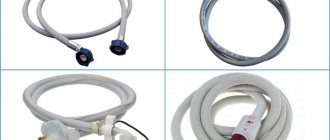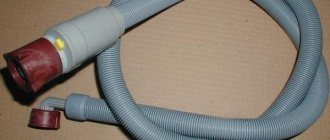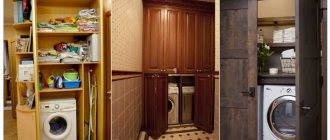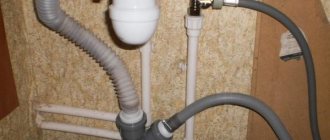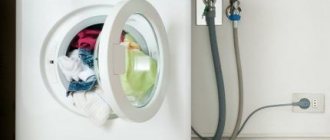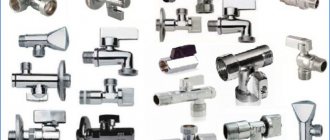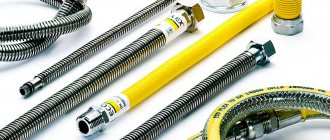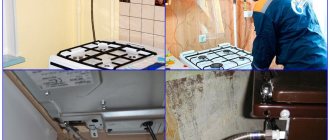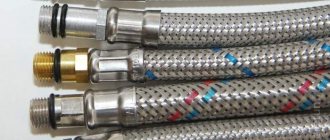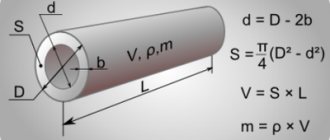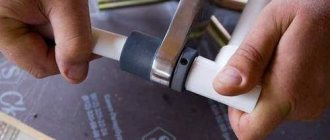General connection diagram for an automatic washing machine
You can install and connect an automatic washing machine (SMA) yourself. It is quite possible to do this, having only a minimum of necessary tools and components, and also following the following algorithm:
- The brought equipment must stand for some time in the room in which it will be installed.
- Next, the washing machine must be freed from the tray and cardboard packaging.
- Regardless of the type of loading of the SMA, its drum is fixed during transportation with special bolts hidden by plastic plugs on the rear wall of the unit. After removing the packaging, the shipping bolts must be removed, otherwise the machine will break down the first time it is started and the warranty will not apply to it.
- The washing machine should be installed on a level base and, using adjustable legs and a building level, the unit should be aligned strictly horizontally. The SMA must stand securely so as not to move due to vibration during washing or spinning, so it is recommended to place it on a non-slip surface, preferably a rubber mat.
- Next, connect the SMA inlet hose to the water supply and lay a corrugated drain pipe to the point of entry into the sewer system. This should be done from behind the washing machine, laying communications along the walls.
- Now you need to connect the Indesit washing machine to a grounded outlet and do a test run.
The figure below shows the left- and right-side connection of the SMA to all communications.
Attention! To connect the washing machine to the electrical network, you need to draw a separate line and install a residual current device (RCD).
Rules for replacing defective hoses
If the leak is not due to a worn gasket, you will likely need to replace the hose. In order to replace the inlet hose with aquastop, you do not need to call a specialist or have any technical skills. This is quite easy to do. To do this, try to follow the step-by-step instructions exactly:
- Turn off the water supply to the tank
- Carefully unscrew the clamps
- Remove the old hose
Now, following the same pattern but in reverse, you can screw on the new one. Before starting, open the tap and clamp the outlet with your palm to check the reliability of the fastening. If you find any, unscrew the adapter and screw it back, but so that everything is level.
Securing the hose
Ready! The inlet hose is in place. Now you can check again to see if there are any leaks. If it no longer drips, then the problem is solved. If it drips in other places, then you have to fix other possible problems with the equipment.
What is the function of the drain hose and its types?
The function of the drain hose of an automatic washing machine, be it LG or Bosch, is quite simple - draining dirty water into the sewer system during the washing process. The drain pipe outlet can be of different lengths and types:
- Polypropylene corrugated hose with a fixed length of 1-5 m. If necessary, it can be extended by connecting two hoses together using a sleeve and clamps.
- Telescopic hose. A universal design, which from 60 cm (in a compressed state) can stretch up to 2 m. However, such a hose clogs faster and vibrates when draining water. You also need to be careful when stretching so as not to damage the material.
- Corrugated polypropylene hose, as in the photo below. It is convenient because you can buy a piece of the required length. However, it is not recommended to use a hose that is too long, since laying it can lead to blockages and blockage of the channel, and these, in turn, often cause the washing machine to stop and break down.
Washing machines are usually equipped with a standard hose for draining water. Elastic rubber fittings Ø19 and 22 mm are attached to both ends. One end of the hose is attached to the SMA, and the other is intended for insertion into the sewer system. If the sewer pipes are located too far away, the drain can be directed into a sink, bathtub or toilet.
Varieties
Before you begin lengthening, you need to familiarize yourself with the main types of hoses.
The inlet hose is a device used to connect the washing machine to the water supply system. It is with its help that water is supplied to the internal elements of the system. Such products operate under high pressure conditions and therefore reinforcement technology is used in their manufacture.
The main material from which the filler tubes are made is polyvinyl chloride, the surface of which is covered with nylon.
The connecting components of the structure can be made of steel, aluminum or plastic. Budget models use plastic fittings that are unscrewed and screwed on manually, without the use of additional tools. When working with steel or aluminum products, you will have to use a special wrench.
A drain hose is used to drain liquid from washing equipment. The following types of drain tubes are distinguished:
- Standard. Such products are produced in a certain length, the length of which can reach five meters.
- Telescopic. These are corrugated products that can easily be stretched to the desired length. When connecting telescopic tubes, you must be very careful so that they do not bend. The kinks may burst under strong pressure.
- Polypropylene. They are made from durable polypropylene. At each end of the product there are special fittings with which a device for washing clothes is connected.
What is needed to install a drain hose
To independently connect the SMA Hotpoint Ariston or Samsung drain corrugation to the sewer system, you need to prepare the necessary consumables and tools. So, you will need:
- splitter or “tee” for sewerage;
- “double” or water seal;
- corrugated hose for extension, however, its total length should not exceed 3 m;
- pipes;
- various connectors;
- sealing coupling;
- clamps;
- siphon;
- silicone sealant;
- adapters;
- pliers;
- screwdriver;
- socket and adjustable wrenches;
- perforator and hammer (if the hose is led into the next room).
To better understand the process of connecting a Samsung washing machine, it is recommended to watch a video that shows all the steps in detail.
Attention! All necessary tools, fastenings and consumables are selected based on the complexity of the connection.
Technical characteristics of inlet hoses
| Company manufacturer | Specifications | Manufacturer country | Length | Price |
| Uglich Polymer Plant |
| Russia | 3m | 66 rubles |
| Cotali UDI-BLACK |
| Italy | 2 m | 358 rubles |
| Electrolux |
| Sweden | 1.5 m | 806 rubles |
| Reflex |
| Italy | 1.5 m | 165 rubles |
| SCANPART 11.200.901.23 |
| Germany | 2.5 m | 599 rubles |
| CODO |
| Russia | 1.5 m | 155 rubles |
How should the drain flexible pipe be positioned correctly?
The height at which it is decided to lay the drain hose is very important, and it, in turn, is determined by the power of the pump that pumps out dirty water. The minimum distance from the floor at which the corrugation can be placed is 550 mm, taking into account that it is connected to a siphon or “tee”. If water will be drained directly into plumbing fixtures, the discharge height should not exceed 1,000 mm. The length of the corrugated pipe recommended by the manufacturer from the machine to the entry into the sewer is about 1,500 mm.
Attention! Incorrect connection of the washing machine will void the right to warranty repair of household appliances.
Poor joining of rubber and plastic components
A leak may also appear inside the hose. For example, in the place where the junction occurs between the plastic and rubber parts. In most cases, the reason is the wear of the rubber half. Over time, the rubber deteriorates, loses its former elasticity and resilience, as a result of which the pressure of the fixing metal frame weakens and begins to leak in this place.
This problem may also occur when moving the machine to another location. At first, you can clamp the adapter with pliers to eliminate or minimize leakage. However, please note that this is a temporary solution and, most likely, you will soon have to install and replace the drain hose inside the washing machine. Actions should be taken in stages. To find out how to disconnect a broken one and attach a working one, read the material below.
Methods for connecting the drain hose
Connecting the SMA drain hose is done in different ways, and each of them has its own advantages and disadvantages. You can organize the discharge of waste water into the sewer system as follows:
- Insertion into a sewer riser.
- Using a "tee".
- Connection via siphon with non-return valve.
- Through plumbing fixtures.
The choice of connection option largely depends on the location of the washing machine.
Insertion into a sewer riser
The drain hose is inserted directly into the sewer system when it is impossible to select and install a “tee”. When connecting the drain using this method, it is recommended to shut off the common house water riser. In order to insert the drain hose into the sewer pipe, you need to use a special cuff, which will prevent wastewater and odors from entering the apartment. The tightness of the connection can be improved using a liquid silicone sealant.
Drain through tee
Typically, plumbing fixtures (toilet, sink, bathtub, shower or kitchen sink) have direct access to the sewer riser. To connect the SMA drain, you can use a “tee”, in which a straight section connects, for example, a kitchen sink and a sewer, and a vertical pipe serves to insert the corrugated drain pipe of the washing machine. It is better to position the plumbing splitter so that the drain hole for the washing machine is perpendicular to the floor. It is also recommended to place a rubber sealing collar in the neck of the “tee” to insert the corrugation.
Attention! To prevent unpleasant odors from the sewer from getting into the washing machine tank, the hose, closer to the point of entry into the sewer, needs to lay the corrugation in the shape of the letter S, but without bending its cross-section.
Using a sink siphon
Some models of siphons for kitchen sinks or washbasins are already equipped with a special removable section with a pipe for external or internal connection of the SMA drain hose. If necessary, it can be purchased separately. When connecting externally, the drain hose must be secured to the pipe using clamps. It is advisable to additionally treat the entry point with silicone sealant to prevent the appearance of unpleasant odors from the sewer and wastewater leakage.
Also, a check valve is often used to connect the drain hose, which prevents the penetration of unpleasant odors into the SMA and the return of waste from the sewer system.
Drainage of wastewater into plumbing fixtures
This is the most accessible and low-cost method of draining wastewater from the SMA. To do this, you don’t have to buy anything in addition, since everything you need is already included in the washing machine kit. A U-shaped frame or plastic holder is placed on the end of the flexible pipe, which can be attached to the side of the bathtub or sink during washing. This method has more disadvantages than advantages and you need to know about them before using it:
- it is necessary that the end of the hose is securely attached to the side of the plumbing fixture, otherwise it may break off when pumping out water and flood the room and neighbors below;
- during the washing process, you should not use plumbing fixtures into which dirty waste water is discharged;
- After discharging waste water, plumbing fixtures will have to be washed, since lint, sand, etc. get onto the surface of the bathtub or sink along with the liquid from the SMA. If you do not wash off all this dirt in time, it will later create many problems during cleaning.
How to attach a drain hose to a bathtub
When choosing a method for draining waste water from a washing machine into plumbing fixtures, you need to securely fasten the corrugation so that it does not come off due to vibration while the pump is operating. Since a bathtub is most often used to discharge wastewater, it is worth considering this option.
Drill a hole in the plastic bathroom overflow grill and screw a self-tapping screw into it. Thread wire or twine into the ears of the bracket for the corrugated pipe and secure it with a screw during washing. Instead of a self-tapping screw, you can hang the edge of the hose from the base of the faucet on the sink.
Incorrect position
It often happens that due to improper positioning, used water stagnates in the tank and sometimes flows out onto the floor. This happens because the hose is skewed or the drain channel is unevenly located, for example, a critical height that prevents the flow of water - it does not leave during draining and partially remains in the tank.
Inlet hose clamp with gasket
To correct this reason, it is important to bring the hose at the junction with the water pipe and drain into a uniform position, so that the skew is no more than 45 degrees. The plastic part should lie flat right up to the drainage point. It is important that the water pressure is distributed evenly. If in any part the pressure is lower than expected, then a leak begins there.
Connecting to the water supply yourself
To properly connect the washing machine with your own hands, you first need to choose the most optimal location. The washing machine is connected through a regular outlet.
In some kitchens, the equipment is installed under the worktop, where it is quite problematic to reach nearby sockets.
Thus, it is more appropriate to place the equipment one and a half meters from the surface of the table SUP (connecting device with a fuse) with a switch, connect it to a ring circuit and mount the wiring using a rigid wire with a cross-sectional diameter of 2.5 mm from the connecting device to the socket located at the back of the machine.
The final stage of installation
When the water is supplied and the correct drainage has been carried out, make sure that the actions are correct. Connecting the washing machine yourself and providing the conditions for its operation is a labor-intensive task, but doable if all the nuances are followed. One of them is choosing the right position.
To prevent the washing machine from vibrating during washing and spinning, we connect it and install it vertically, adjusting the position of the body using the legs. For this purpose, a construction standard is used.
It is placed on the lid and the height of the legs is measured, with the level bubble located in the center. The measure is laid parallel to the front side, gradually making a shift towards the back wall. The process is repeated with the level positioned on the sides of the body.
Removing the shipping bolts
Before performing the main work, the transportation bolts are removed - fasteners that ensure the safe movement of washing equipment to its destination. Their main function is to protect the equipment tank from damage during transportation.
In standard models there are only four of them. They are located at the back at an equidistant distance from each other.
To remove the fasteners you will need a wrench for unscrewing 10, 14 mm nuts and pliers. Each bolt has a pin. He comes out first. Afterwards, pliers are used to remove the entire bolt using the tack-and-turn method. These steps will help you quickly remove the shipping bolts. The remaining holes are plugged with plastic plugs.
We change the hose in German-made cars
For washing machines from German manufacturers (AEG, Bosch and some others), in order to replace the drain hose and get to the pump, you will first need to remove the front part of the case. After this, you can get down to business.
- Remove the dispenser container
- Unscrew the plinth panel
- Remove the clamp holding the rubber door seal away from the hopper. Next, disconnect the rubber cuff from the front wall of the case
- Now carefully move the lower part of the wall to the side, and then towards you, to create a gap about two fingers wide
- Now find the hatch blocking device there. The mechanism is activated when the hopper door is closed. Unplug the connectors with wires from this device
Ready! Now you can start replacing parts according to the above mentioned scheme. German models are more complex than their Italian or Korean counterparts, but the hoses are changed in the same way. The only difference is the number of panels and walls.
Electrical connection
How to connect a washing machine to electrical power correctly? To do this, use the following algorithm:
- The power of the washing machine is large, so it is advisable to install a separate switchboard line.
- Provide the outlet with grounding to eliminate static.
- Selecting a protective fuse. To do this, the power of the equipment (indicators from the technical characteristics) is divided into 220 V. The result obtained shows the amount of current consumed.
- Selection of RCD. Based on the current strength, it is selected by an order of magnitude higher than the nominal value of the machine. For a 16A machine, a 32 A RCD is suitable. Based on the current leakage, other characteristics are obtained. Devices connected to a separate line accept a value of 10 mA. Based on these characteristics, a 3.5 kW machine is compatible with a 16 A, 32 A, 10 mA machine.
- Socket. The socket for the machine is selected based on the markings on the back side. So, they find out the permissible voltage for which it is designed. If there are no markings, you have purchased a dangerous counterfeit and the socket should not be used.
Replacing a hose for Electrolux and Zanussi cars
For cars of this brand, the first thing you need to do is remove the rear part of the body. This will allow you to reach the pump to which the drain hose of your washing machine is attached. We proceed according to the following scheme:
- Unscrew the screws holding the cover on the back side. This will be needed to remove the upper housing, then push it to the side
- Remove the screws holding the back cover in place. You may also need to remove the plug
- Remove the fill valve retainer
Ready! Now you can, following the previously mentioned scheme, replace the hose. You will not need to perform any unnecessary actions, since the drain channel is designed almost the same as in models of other brands.
